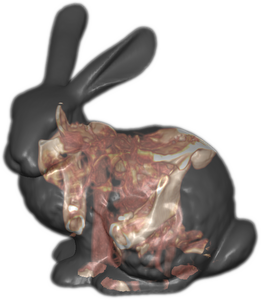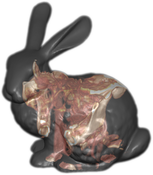Information
- Publication Type: Conference Paper
- Workgroup(s)/Project(s):
- Date: November 2006
- Location: Aachen, Germany
- Lecturer: Maurice Termeer
- Booktitle: Proceedings Vision, Modeling and Visualization 2006
- Keywords: volume clipping, sharp edges
Abstract
Volume clipping is a useful aid for exploring volumetric datasets. To maximize the effectiveness of this technique, the clipping geometry should be flexibly specified and the resulting images should not contain artifacts due to the clipping techniques. We present an improvement to an existing illumination model for volume clipping to allow sharp edges in the data to stay visible. These sharp edges often originate from material transitions in the volume or structures being partially cut by the clipping geometry. The focus is on high, industrial image quality and flexibility of the algorithm; techniques for using high-resolution polygonal meshes as clipping algorithms and removal of artifacts are presented. Features of the latest consumer graphics hardware are exploited to provide the visualization at an interactive framerate without the need for multipassing. We have validated the techniques presented here by implementing them in the context of a professional volume rendering application at Philips Medical Systems, and comparing our results with current results produced by existing solutions.Additional Files and Images
Weblinks
No further information available.BibTeX
@inproceedings{termeer-2006-000,
title = "Preserving Sharp Edges with Volume Clipping",
author = "Maurice Termeer and Javier Oliv\'{a}n Besc\'{o}s and
Alexandru Telea",
year = "2006",
abstract = "Volume clipping is a useful aid for exploring volumetric
datasets. To maximize the effectiveness of this technique,
the clipping geometry should be flexibly specified and the
resulting images should not contain artifacts due to the
clipping techniques. We present an improvement to an
existing illumination model for volume clipping to allow
sharp edges in the data to stay visible. These sharp edges
often originate from material transitions in the volume or
structures being partially cut by the clipping geometry. The
focus is on high, industrial image quality and flexibility
of the algorithm; techniques for using high-resolution
polygonal meshes as clipping algorithms and removal of
artifacts are presented. Features of the latest consumer
graphics hardware are exploited to provide the visualization
at an interactive framerate without the need for
multipassing. We have validated the techniques presented
here by implementing them in the context of a professional
volume rendering application at Philips Medical Systems, and
comparing our results with current results produced by
existing solutions.",
month = nov,
location = "Aachen, Germany",
booktitle = "Proceedings Vision, Modeling and Visualization 2006",
keywords = "volume clipping, sharp edges",
URL = "https://www.cg.tuwien.ac.at/research/publications/2006/termeer-2006-000/",
}


